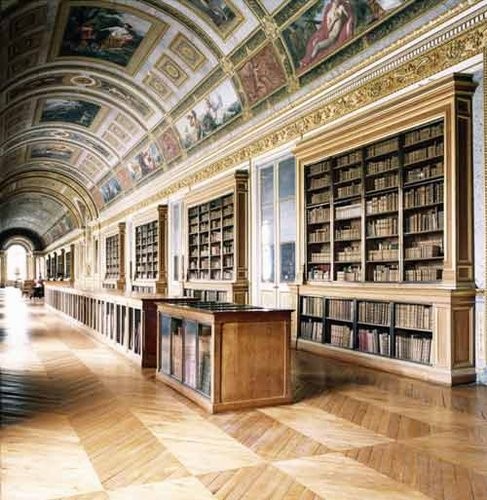Candida Höfer
26 Mar - 08 May 2010
CANDIDA HÖFER
26.03. - 08.05.2010
Candida Höfer is undisputedly one of the leading international artist photographers of the present day. Her themes are mostly deserted interiors of artistic and cultural significance – places of knowledge, education and art appreciation, such as libraries and museums, prestigious interiors of palaces and churches, of edifices of secular and religious power, or places of cultural exchange, such as the foyers and auditoriums of famous theatres and opera houses.
Candida Höfer’s large-format photographs are mostly objective in character. She prefers to use central perspective for her motifs or guides her camera into a kind of ideal diagonal. It is not the recognition effect of these prominent interiors that comes first and foremost in her work but rather the composition resulting from the choice of detail. What at first glance seems, by reason of its sheer perfection, to be entirely unspectacular turns out upon closer scrutiny to be a system of order inherent within the entire architecture, a system that recurs with rhythmical precision throughout the photographic image, from its foreground into its depths. Attributes distributed at random, such as a book left lying around, a forgotten bucket or a pushed-aside barrier, disturb the strictness of the system and tell us that people were present only moments before.
The title image of the exhibition is the famous Juno Room of the National Goethe Museum in Weimar. The eye-catching feature of this imposing interior is the Juno Ludovisi, a large plaster of Paris bust of Antonia Minor as the Roman goddess Juno. Candida Höfer shows this bright and empty room in a composition of extreme severity and clarity, almost tangibly evoking the spirit of the Enlightenment.
One of the focal points of the exhibition are Candida Höfer’s photographs from Paris, Versailles and Fontainebleau. Her photographs of the Louvre, taken in 2005, count among the gems of museum photography, which is meanwhile a genre in its own right. Originally a royal palace, the Louvre museum has forever been a favourite motif of artists. Candida Höfer has concentrated on just a few of its galleries, including the Grande Galerie as the top-lit central axis of the building, the Salle des Caryatides and other rooms and galleries of painting and sculpture.
Motifs from the Opéra Garnier belong to a series of works devoted to the two large Parisian opera houses Palais Garnier and the Opéra Bastille. The exhibition shows a few selected works from the Palais Garnier, including the monumental staircase and the red and gold auditorium – scenes of triumphant representations in the style of the Second Empire.
Candida Höfer, born in Eberswalde in 1944, studied photography under Bernd Becher at the Düsseldorf Art Academy during the late 1970s and early 1980s. She lives in Cologne.
26.03. - 08.05.2010
Candida Höfer is undisputedly one of the leading international artist photographers of the present day. Her themes are mostly deserted interiors of artistic and cultural significance – places of knowledge, education and art appreciation, such as libraries and museums, prestigious interiors of palaces and churches, of edifices of secular and religious power, or places of cultural exchange, such as the foyers and auditoriums of famous theatres and opera houses.
Candida Höfer’s large-format photographs are mostly objective in character. She prefers to use central perspective for her motifs or guides her camera into a kind of ideal diagonal. It is not the recognition effect of these prominent interiors that comes first and foremost in her work but rather the composition resulting from the choice of detail. What at first glance seems, by reason of its sheer perfection, to be entirely unspectacular turns out upon closer scrutiny to be a system of order inherent within the entire architecture, a system that recurs with rhythmical precision throughout the photographic image, from its foreground into its depths. Attributes distributed at random, such as a book left lying around, a forgotten bucket or a pushed-aside barrier, disturb the strictness of the system and tell us that people were present only moments before.
The title image of the exhibition is the famous Juno Room of the National Goethe Museum in Weimar. The eye-catching feature of this imposing interior is the Juno Ludovisi, a large plaster of Paris bust of Antonia Minor as the Roman goddess Juno. Candida Höfer shows this bright and empty room in a composition of extreme severity and clarity, almost tangibly evoking the spirit of the Enlightenment.
One of the focal points of the exhibition are Candida Höfer’s photographs from Paris, Versailles and Fontainebleau. Her photographs of the Louvre, taken in 2005, count among the gems of museum photography, which is meanwhile a genre in its own right. Originally a royal palace, the Louvre museum has forever been a favourite motif of artists. Candida Höfer has concentrated on just a few of its galleries, including the Grande Galerie as the top-lit central axis of the building, the Salle des Caryatides and other rooms and galleries of painting and sculpture.
Motifs from the Opéra Garnier belong to a series of works devoted to the two large Parisian opera houses Palais Garnier and the Opéra Bastille. The exhibition shows a few selected works from the Palais Garnier, including the monumental staircase and the red and gold auditorium – scenes of triumphant representations in the style of the Second Empire.
Candida Höfer, born in Eberswalde in 1944, studied photography under Bernd Becher at the Düsseldorf Art Academy during the late 1970s and early 1980s. She lives in Cologne.

